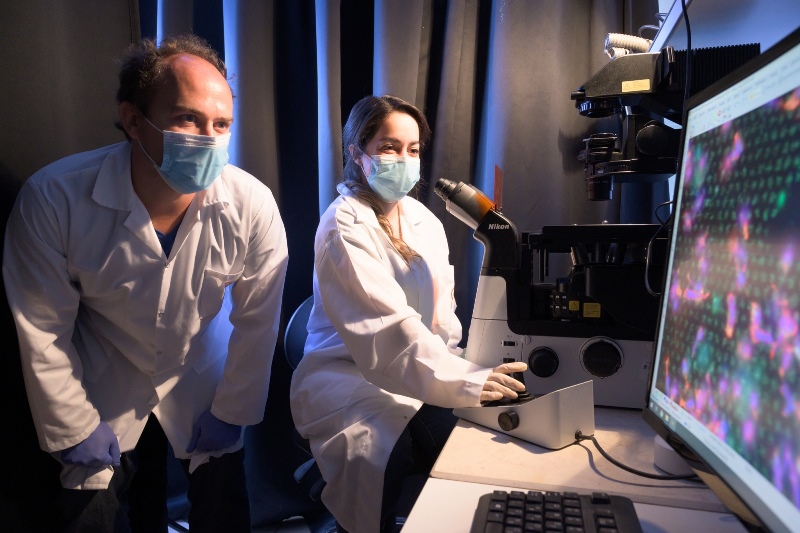The coronavirus, SARS-CoV-2, which is responsible for the current COVID-19 pandemic, is transmitted between people mainly via respiratory droplets, but it is known that the virus remains stable on various surfaces for days. One of the first indications for this came from the Diamond Princess cruise ship, where active virus particles were found even 17 days after the ship was evacuated. In light of the possibility that the virus can spread through contaminated surfaces, it is important to be able to sterilize surfaces with high contamination potential, such as doorknobs, elevator buttons or handrails in public areas in general, and in hospitals and clinics in particular. However, current disinfectants are mainly based on chemicals such as poisonous sodium hypochlorite (bleach) or alcohol, both of which provide only a temporary measure until the next exposure to the virus.
Prof. Angel Porgador, from the Department of Microbiology, Immunology and Genetics at BGU and the National Institute of Biotechnology in the Negev (NIBN), and Dr. Mark Schvartzman, Department of Materials Engineering at BGU, are developing novel surface coatings that will have a long term effect, and contain nanoparticles of safe metal ions and polymers with anti-viral and anti-microbial activity.
Certain metals can be lethal, even in small quantities, for viruses and bacteria and are not poisonous to humans. In proof of concept experiments, in which also PhD students Yariv Greenshpan and Esti Toledo (pictured below), and postdoc Guillaume Le Saux (pictured below) participated, the researchers assessed the effect of surfaces coated with nanoparticles of various metals on the infectivity of lentiviruses, which belong to the HIV family, in human cells. Findings show that surfaces coated with copper nanoparticles strongly block infection of the cells by the virus. These ongoing experiments show a huge potential for copper ions in preventing surface-mediated infection with SARS-CoV-2.
Based on these findings, the researchers are developing anti-viral coatings that can be painted or sprayed on surfaces. The coatings are based on polymers, which are the starting materials of plastics and paints, and contain nanoparticles of copper and other metals. The nanoparticles embedded in the polymer will enable controlled release of metal ions onto the coated surface. Studies show that these ions have a strong anti-viral effect, which can eradicate virus particles that adhere to the surface. Because the release of ions is extremely slow, the coating can be effective for a long period of time – weeks and even months, and it will reduce the infectivity of the virus particles by more than 10-fold.
Josh Peleg, CEO, BGN Technologies, said, "The need to develop anti-viral coatings has greatly increased recently, with the SARS-CoV-2 outbreak, and this need will likely remain high even after the pandemic ends, due to increased awareness. In addition, the product will be efficient as a general anti-viral and anti-bacterial coating. It can be applicable for medical settings, as an anti-pathogenic substance in places with increased risk of contamination, such as hospitals, but also for home use, and in public spaces such as schools, airports, public transportation and cinemas. We see a widespread and multidisciplinary academic commitment for finding solutions to currently medical and financial challenges as well as to the challenge of returning to normalcy once the pandemic wanes."
The research activity of Prof. Porgador and Dr. Schvartzman is part of the coronavirus research task force, founded by Prof. Daniel Chamovitz, President of BGU. To support this activity, it was decided to divert research funds in order to find rapid solutions for various challenges associated with the coronavirus pandemic. This invention received the support of the Israel Innovation Authority, in response to a call for proposals for coping with the coronavirus. The project is one of 27 proposals submitted to the Israel Innovation Authority by BGN Technologies, the technology transfer company of BGU, based on innovative and diverse inventions of researchers at BGU and the National Institute for Biotechnology in the Negev (NIBN) for the prevention, diagnosis and treatment of COVID-19.
Prof. Angel Porgador said, "The current coronavirus is transmitted not only through droplet spray but also via various surfaces that can convey the virus from one person to another. Furthermore, research shows that the virus remains viable on various surfaces for extended periods of time, of days and even longer. Therefore, there is a clear need for durable anti-viral coatings that can be sprayed or painted on surfaces, just like paint or varnish, and that will prevent viral transmission. These surfaces can include handles, buttons, railways or any other public surface that poses increased danger, in particular in places with a high concentration of potential carriers, such as hospitals or clinics. It is important to remember that we are developing coatings that will be effective not only against the coronavirus but also against other viruses, as indicated in our proof of concept experiments, and also against bacteria, so they will be relevant for a wide range of applications."
Dr. Mark Schvartzman commented, "While current surface disinfection methods rely mostly on substances that are poisonous for people, such as bleach, or on substances that evaporate readily being based on alcohol, the coating that we are developing is based on metals that are toxic for viruses or bacteria, but completely human friendly. It should be noted that until now using such metals for anti-viral applications has encountered significant challenges due to the nature of the metals, such as the tendency to oxidize and corrode. Nanoparticles provide a solution to these obstacles. Another advantage of nanoparticles is the large surface area to volume ratio, which results in an efficient anti-viral surface area using a relatively small amount of metal. Additionally, nanoparticles of anti-viral metal can be easily embedded in a polymer that can coat the relevant surfaces for extended periods of time."

Above: Guillaume Le Saux and Esti Toledo at Dr. Mark Schvartzman's laboratory
Media Coverage:
JPost
Globes
NoCamels
BioSpectrum